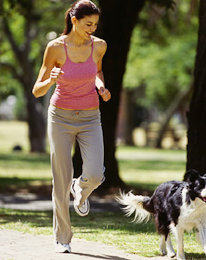Jogging Workout
Jogging involves moving at a pace faster than a walk but slower than running. The movement itself is closer to that of running but the energy level is less. Technically speaking, jogging is running at a speed of less than six miles per hour. The main goal is to promote physical fitness without the stress on the body often caused by running. Not much equipment is required for jogging. Comfortable athletic clothing and running shoes are recommended. Weights can be used in the hands or on the ankles to increase the resistance and build the muscles further. Also, a treadmill can be used if there is nowhere outdoors to jog or if being indoors is preferred. Cost:$30 to $500 Your costs will depend on your taste, but you'll want to find a good pair of running shoes at the minimum. If you prefer to jog at home, you can invest in a treadmill. Activity Locations: Home, Outside or the Gym When the weather is good, a jog in the park or around your neighborhood can give you many more health benefits than jogging inside. But some people prefer to use a treadmill, especially those in larger cities. Types of MovementsJogging can be done by oneself or in a group. It can be done at a variety of speeds for a variety of distances. It can also be done indoors on a treadmill or on an indoor track. Jogging is a slower form of running, meaning that while jogging, there are times when both feet are off the ground. While walking (at least competitively), one foot must be on the ground at all times. Jogging often has smaller steps sizes than running. It is possible to benefit from jogging in place as well. Mental and Physical RequirementsYou should be in good physical condition before beginning a jogging routine. Otherwise, a walking routine may be required until you are fit enough to begin jogging. Most beginning exercisers start with walking, then add interval training, before finally moving on to jogging and running. Equipment Requirements
Mental and Physical BenefitsMental
Physical
Aerobic Effect
Jogging is considered an aerobic exercise type since it has the ability to elevate the heart rate and achieve an "aerobic effect". This is accomplished by forcing the heart to increase in the number of beats per minute to increase level of oxygen that is distributed throughout the body. The primary muscles used when jogging include the entire core area, the quadriceps, the hamstrings, the gluteals, the calf muscles, and the hip flexors. In addition, the heart, as it is considered a muscle, is heavily exercised as well. Jogging also promotes safe and effective weight loss. Even at a moderate pace, a 150 pound person will burn approximately 544 calories per hour. Jogging is also effective in reducing the risk of cardiovascular disease, improving bone density, and reducing the risk of osteoporosis. Jogging has also been shown to reduce stress, boost self esteem, and promote an overall sense of contentment and well being. Finally, jogging has also been used as a preventative technique for individuals at risk for diabetes and hypertension. |
Copyright © 2025 FitnessHealth101.com All Rights Reserved
FITNESS TOPICS
FITNESS REVIEWS
FITNESS & HEALTH GLOSSARIES

